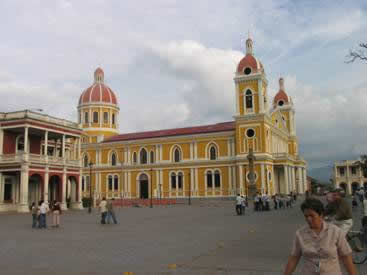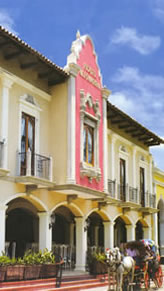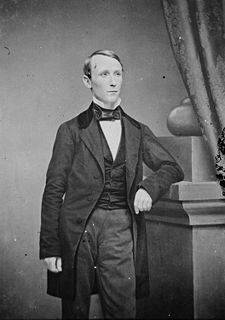Granada-Nicaragua, What's-in-a-Word Department , Beach Attack
|
The What’s-in-a-Word Department in this issue is longer than usual because my new Spanish teacher kindly took the time to review past issues of the GG Chronicles and suggest improvements (he’s too polite to call them corrections). Also in that department, the infamous fruit, the Limone, has surfaced once more and, I hope its definition has been finally put to rest. Muchísimas gracias Jorge, mi amigo y prófessor; pura vida! gg |

Volcano Isazu at Sunset - What Can I Say - It's Worth a Thousand Words |
Granada-Nicaragua
The time came once more for our hero to leave Costa Rica for 72 hours to renew his visa. The process is simple but necessary and involves nothing more than getting an exit stamp on the passport and another entrance stamp 72+ hours later.
This is the third time GG has made this kind of trip in order to stay within the confines of Costa Rican law. The first trip was to David, Panama (Episode 6), the second to San Andres Island, Colombia (Episode 9) and now to Nicaragua. My residency document and permit is in the works (“in trámite” as they say here) so, hopefully, this will be the last time I am required to do this. Actually, the process gives me a good excuse to break the routine and visit someplace new, but I may be running out of cheap places to go without repeating where I’ve been.
I bought the round trip bus ticket for San José/Granada in San José about a month before the trip. The Nicaraguan transportation company providing this service is called TransNica (clever, eh? – note that the “eh” is used here once again in deference to my Canadian friends). TransNica’s terminal is located a few blocks from San José’s infamous Coca-Cola bus depot. (I must remind myself to investigate the origin of the name, or nickname for this station; did Coke fund it originally?) I wanted the 7:30 AM bus but was told that only the 4 AM and 5 AM buses had available seats. I chose the 5 AM bus and was issued a ticket for seat #1 which made me suspicious that either I was being managed into the 5 AM bus by my Nica service attendant or my Spanglish failed once again to communicate adequately. (It’s probably the latter)

|
|
Since the bus to Granada was so early I decided to make the Quepos to San José trek the day before. In S.J., I bedded at a small hotel (7-rooms) that I’ve stayed at twice before and which is only 1½ blocks from the Teatro Nacional. The NationalTheatre is a beautiful old building in the heart of the city that is essentially the Kennedy Center of Costa Rica. The fellow who owns the hotel is a South African named Alfi (like in what’s-it-all-about). Alfi is a congenial old fart (that means he’s my age) who loves to regale his guests with numerous stories about his adventures in life. He was born In South Africa, grew up in Kenya and has lived in Mexico, Europe and the United States before finally settling in Costa Rica.
|
The lobby or atrium of the hotel is peppered with African art pieces and paintings, the latter being Alfi’s own work. He has a story about each painting. One depiction is a good rendering of his wife who died some years ago. There are a number of pictures (I guess that’s what the unknowledgeable like myself call oil paintings) of elephants, lions and other beasts of the savannah. After we chewed the fat awhile, Alfi mentioned that I was the last of three guests to check in that night. I suggested we go to dinner together and he quickly accepted, leading us on a grand saunter past the Teatro and down the walking street know as Avenida Central. We ended up at a wonderful little Italian place where the food was excellent and cheap and where I could banter all 6 or 7 words of my Italian with the Tico waiter.
My travel alarm went off the next morning at 4 AM and I quickly and surreptitiously scurried out of the hotel into the dark, leaving my room and door keys on the desk and locking my self out the front door. I just love small hotels for this kind of thing. A quick walk to the Teatro Nacional produced a taxi, along with its sleeping driver, and in three minutes and for ¢800 ($1.40) we traversed the empty streets of San José and arrived at the TransNica terminal. I felt good about having adhered to the bus company’s posted policy to be there 45 minutes before boarding time, even if it was 4:15 AM. Forty minutes later we boarded the bus just like any other Latino Land “boos” – why we needed to be there 45 minutes is still a mystery to me. Most of the Ticos, Ticas and Nicas (unlike Ticos/Ticas, the term Nicas covers both men and women of Nicaragua) knew the system better and arrived at quarter to the hour.
The early arrival did, however, give me the opportunity to talk with a Tico who was helping families unload baggage in front of the terminal. He quickly sized me up as a gringo (fancy that) and we jabbered together for the next 30 minutes before he became too busy to talk. I am often amazed at how many details you can learn about a total stranger in a brief intercourse in a strange place, without having to give up the gory details of your own story. I learned that Carlos was 46 and from a family of eleven children, that he had lived in the States (mid-west, I think St. Louis) for 6 years and has a university business degree. He now has AIDS (he was indeed quite thin) and harbors a resentment toward Costa Rican companies who would not hire him because of the potential cost associated with his disease. He didn’t dwell on his health problem though, and we had a pleasant conversation about his remembrances of living in the States.
Departing precisely on time, the bus wound its way out of San Jose along the highway to the airport, then through Alejuela, the second largest city in Costa Rica. According to published figures, the central valley of Costa Rica, comprised largely of the cities of San José and Alejuela and their surroundings, holds as much as two-thirds of the total population of the country. That would put the number of people in the valley at around 3,000,000, with the other 1,500,000 widely dispersed in all directions. After picking up several more passengers in Alejuela, we headed West and North along Route 1, the Pan American Highway, eventually going through Liberia towards the Nicaraguan border. At one point we stopped at a restaurant on the top of a mountain with a great view and I enjoyed a breakfast of heuvos fritos and spotted rooster (see What’s-in-a-Word below for more about spotted rooster).

|
|
Including the breakfast stop, it took about five hours to get to the border from San José. The good news was that the bus was air conditioned and I was fortunate in that the seat next to me was empty so I could spread out a little and read my latest tome, a weighty but fascinating work on the political astuteness of Abraham Lincoln.
When we got closer to the border, the topography gave way to flatter and hotter land and I noticed, over a distance of 20-30 kilometers, a series of strange trees edging the highway. They were long-needled pines and they were unusual because almost all their branches were bent back in the direction I was coming from. Images flashed before me of the way similar trees act in the middle of a hurricane or of those old movies of the blast effect from the first atomic bomb tests in New Mexico. I soon forgot about the bizarre trees, however, as we arrived at the border not long after. |
The border process requires four steps and four forms. The first two steps involve the Costa Rican authorities, where one must get an exit stamp in one’s passport and turn in an immigration form. This was a simple process but slow as there was only one passport clerk to process our 56 people. After this step was accomplished, the bus driver’s assistant collected the passports and customs declarations for all the passengers and proceeded ahead to get a Nicaraguan entrance stamp for each.
We next pulled up to a depot island with a high roof and open sides just in time to experience a driving rain storm. Because we had to pass Nicaraguan customs inspection, all of the baggage had to be removed from the baggage compartment of the bus. With so many people milling around and trying to avoid the rain by getting on the downwind side of the depot with their belongings, most people got wet. Having only my backpack (I’ve gotten pretty good at living out of a medium sized back pack for 3-4 days) the driver was kind to me, took my customs form with no declarations and said I could board the bus. I only got damp. While I waited for the rest of the passengers to pass inspection, I watched the rain coming into the depot in heavy, slanted sheets. It wasn’t hurricane force but not that far from it either. It was then I understood what happened to the pine trees.
After all passengers had boarded the bus, the driver’s assistant reappeared and raffled off the stamped passports in another slow process. Next, the bus pulled ahead 50 meters where upon a gentleman with a white face mask boarded, and starting from the back, took the forms and asked questions. This last process took a total of 45 minutes before we were released. I was advised by another passenger that the border health authorities are more cautious than normal these days because of the fiébre porcina (swine flu). The border process in total, took one hour and forty-five minutes. (On our return it would take 2 hours) We finally arrived in Granada at 1 PM, 8 hours after we left San José. (On our return, the total time elapsed would be 9 hours)

|
|
The bus route we took is actually San José to Managua and Granada is only an intermediate stop. I was dropped off in Granada along one of the streets in the city and almost immediately found a taxi. A few days earlier I had emailed the hotel and gotten detailed instructions on how to find it, so I produced the paper and gave it to the taxi driver. Despite this, the hombre couldn’t find the hotel so, after a five minute drive he dropped me off and pointed down the street a couple of doors to where he thought the hotel ought to be. Well, of course it wasn’t there. I had also been pre-warned by the hotel that I shouldn’t pay more than $1 for the taxi ride, so I offered a one dollar bill and the driver seemed quite happy to get it. I would learn later that taxi fares in Granada for going between any two points in the city are mandated by law to be 10 Córdobas (one dollar equals 20 of these).
As I walked around, looking every bit the confused tourist, a Nica gentleman approached and offered to lead me to the hotel. It turned out to be only two blocks away. I tipped him $2, with which he seemed exceedingly happy. So there I was, only 20 minutes in Granada and already having spent a whole $3; I would need to watch my pace of spending more carefully!
|
The hotel turned out to be a delightful little place with four rooms and a garden with an atrium in the center open to the sky. A long table aside the garden is used for breakfasts. The place reminded me of Alfi’s hotel in San José except Alfi doesn’t have a garden in his atrium; just a large hand-carved birdcage with one little finch that attracts and frustrates Alfi’s hotel cat Leo. (Poor Leo has schizophrenia and sometimes thinks he’s a lion – at one time there were two finches but Leo managed to cause one to die of freight) It turned out that my Granada hotel is owned by two Belgian gentlemen from Antwerp and my having lived in Brussels for a few years gave us the basis for several hours of discussion over the three nights and four days I was there. Jan and Francis were also indispensible in giving me tips on what to see and what to do while in Granada.
I spent the first afternoon walking around the city, particularly the central square area which is lined on all sides by quite impressive colonial Spanish architecture. The city currently is home to about 110,000 people. The popular tourist things are (1) a city tour by horse-drawn carriage to see the architecture and museums, (2) a visit to the extinct volcano named Mombacho, and (3) Lake Cocibolca, commonly known as Lake Nicaragua, with its series of small islands (Isletas) originally formed by Mombacho blowing its top off some 400 years ago.
I must admit, I am no fan of volcanoes. I haven’t yet visited Arenal in Costa Rica, a very popular tourist destination. My reluctance comes from the only visit I ever made to a volcano, back in the ‘70’s. We were in Italy on vacation and motored up the side of Mount Vesuvius just outside Naples in a Fiat 500 only to find a big hole in the ground with many steam vents gushing white vapors. Whoopee. I felt the day would have been a total loss had we not taken a tour of Pompeii followed by a nice lunch in a petite restaurant near an ancient, two-story bathhouse and brothel (those Romans knew how to live). So, in my mind, the volcano was out. The Isletas tour looked interesting but I saved it for my second full day in Granada and, as it turned out, it rained heavily at the time I wanted to take it, so I passed on it also, at least until my next trip.

Granada City Carriage Tour |
|
|
On my first full day there, I decided to take the carriage tour. The hotel suggested a certain driver who spoke good English and he appeared at the door of the hotel entrance at the appointed time. Alvaro was twenty years old and a student studying English, among other things. His English was much better than my Spanish so we got along quite well. The hotel had pre-warned me that the carriage drivers would try to stretch out the time by suggesting you visit every museum in the city while they waited with the naying and grunting horses. I ended up using my carriage for only an hour ($15) but saw most of the Spanish colonial architecture in the city, many buildings of which are candidates for renovation when cash flow gets better. My favorite site was William Walker’s house, dating back to the mid-1850’s. |
If you don’t know William Walker, this dude was one of the more interesting cats to have influenced Central America (or tried to). Born in Tennessee, Billy got a law degree, practiced in Philadelphia a while then, suffering from delusions of grandeur, formed a mercenary army and went west to “liberate” California. He was partially successful in the Baja Peninsula and proclaimed himself President of Southern California (of course this was before Michael Jackson became King). He then turned southward to Central America (actually, he was kicked out of California), leading a group known as “The Immortals” (whoa, Walker doesn’t sound Greek to me). He set his sights on becoming Emperor of Nicaragua, setting up the base of his kingdom in Granada. He met with much frustration as U.S. President Buchanan, the British and many of the locals all worked against him, to his eventual demise.
At one point Billy’s Boys marched into Costa Rica where they were defeated by the Tico Army (back when Costa Rica had an army) and Juan Santamaria, a young drummer boy who torched W.W.’s fort and became a national hero in Costa Rica (the national airport is named after Juan). Eventually, the British caught Billy and turned him over to the Hondurans where he was summarily executed. The Honduran military don’t fool around, just ask the recent ex-president Zelaya. |
|

W.W. – The Beady Eyed Devil Himself |
|
What’s-in-a-Word Department
Spotted Rooster
Those of you who have visited here know of Gallo (Guy-oh) Pinto, that peculiarly Costa Rican dish of rice and beans and other stuff that is served morning, noon and night as an accompaniment to eggs, meat, fish, well… just about everything. It’s a simple thing that slowly grows on your palette; you can go just so long before you need some, like Boston Lobster, a Philly Cheese Steak or Belgian Frites. The contents are simple (rice, black beans, and a smattering of aromatic vegetables) but there are as many recipes for it as there are Costa Ricans. And there are a few secrets also, among them being the right amount of cilantro, garlic and an appropriate dash of Lizano Sauce, that vinagretti, mildly spicy juice also peculiar to Ticoland. Gallo Pinto is often made in big batches and stored in the fridge until a dollop is needed to round out a meal.
My Spanish teacher recently pointed out that the most common meaning of Gallo is Rooster. Gallo may also be used to indicate a snack but rooster is more prevalent. Just look at all the Costa Rican stores (e.g. Gallo mas Gallo) and chicken restaurants out there with the rooster as a symbol. Pinto, on the other hand is Spanish for spotted, like a leopard or cow. So there you have it, or should have it if you can find it or make it – spotted rooster.
Muchas Correciones
As I mentioned earlier my Spanish teacher was kind enough to review the last few Chronicles. It’s obvious that I need much more practice in writing Spanish, particularly in spelling and the inflection marks or “guions”. Here are the corrections (the black is how I wrote it originally, the red is the corrected version.
San Jose = San José; Cedula = cédula; Gymnasio = Gimnasio; Mucho Musculos = Mucho(s) Músculo(s); Jorje = Jorge; vendador (plural: vendadores) = vendedor (plural: vendedores); Disculpame amigos = Discúlpenme amigos; Oscar Arias Sanchez = Óscar Arias Sánchez; Jaco and San Jose = Jacó and San José; Muchas gracias, amiga, para has encuentrando estas errors = Muchas gracias, amiga, por haber encontrado estos errores; San Andres Island = San Andrés; “Oh, no Senor” = ‘Oh, no Señor’; Columbia = Colombia (even in English); Nicos = Nicas (same for both masculine and feminine); Estadounidensis = Estadounidenses; Canadiensis = Canadienses.
Whew! Enough already, I’ll try harder. Let’s just say there appears to be ample room for improvement.
Re-Re-Corrections
In the last issue I wrote the following: “In Issue 7 I referred to that tart, mottled-skinned, lemony citrus fruit peculiar to Costa Rica as a Limone (lih-mo-knee). I then corrected the pronunciation in Issue 8 to drop the “e” on the end; it became “Lee-moan”. Now I’ve been told that Costa Rican limones are really limes and the correct name for the fruit in question is Manadarina, a name taken from the area where they are grown.”
Again my Spanish teacher came to the rescue: FYI Bob, we have lemons=limones, limes=limas, limón dulce=sweet lime, mandarina=tangerine and limón mandarina= tangerine lemon! No wonder I can’t figure it all out; Costa Rica has more types of lemons than Carter has liver pills (if you’re under 35, you probably won’t recognize that phrase). That last dude, the limón mandarina, is the one I pucker up to in the morning.
Beach Attack
In the last issue I reported how the U.S. Marines invaded Quepos one morning recently. (I’m tempted to submit to them an edit of their song: ♫”From the fields of Quepolandia, to the shores of Tripoli…♫ - it fits!). The latest military operation took place on Sunday, July 12. (Well, it was really just the Fuerza Publica, a kind of a national police based in San José) The F. P.’s forces descended on the main Manuel Antonio beach, shutting down and evicting every one of the vendarenas (see last issue) along the beach. I couldn’t even rent a beach chair or umbrella, let alone have a great casado for lunch at one of the impromptu soda tents (here, the term soda refers to a simple and small restaurant like a luncheonette) near the water’s edge. This was a crisis at least equally important as the world financial situation. My serenity was challenged, life was in tatters.
The story goes that all these vendors don’t pay permit fees or sales taxes. Yeah, so what’s your point Gestapo? Krystalnacht behavior is not a good strategy in my book. Wouldn’t it make more sense to have a small task force of local police with a couple of tax men visit each vendor to get them to comply and maybe jail a couple for emphasis? The heavy-handed way the attack was done did not produce one red colone more in permit fees or taxes than they got before.
I suppose the logic includes the thinking that the beachgoers will be driven into the local restaurants and shops. In fact though, what I saw was a significant drop in people on the beach in the week following the raid. The sight of heavily armed paramilitary in bullet-proof vests and sporting assault rifles, pistols, carrying billy-clubs and mace weapons, along with a police barrier to be negotiated before you reach the beach, does not make for an attractive beach.
By the end of the month, a small number of vendors were showing up again but they were restricted to a narrow area north of the main beach. Rumors had it that la policía would be returning to San José shortly and the vendors would be back like flies to the honey.
Rest assured that freedom of the press will triumph here and your reporter will bring you updates and breaking news as it happens. You won’t get it from Reuters, but you will get it from the Chronicles.
|

